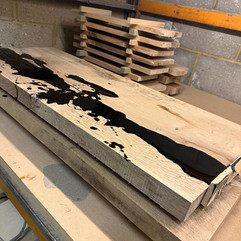Top Tips When Using Resin with Our Timber
- Whitwell Sawmill

- Oct 18
- 3 min read
If you’ve ever scrolled through social media you will no doubt have spotted some resin pieces, be it a beautiful river table or a resin vase or decoration. Resin is something we frequently use with our timber and its effects can be both bold or subtle depending on the desired effect. As we offer various workshop services we are more than happy to do this resin work on our planks for you but we also sell the resin kits for you to be able to do this yourself at home. Various pigments are available too so you can add some colour to your pieces should you wish. If you’re looking to do the resin yourself we thought it would be handy to share some of our top tips to help you with the process.
Purchase good quality resin to ensure you get the best possible outcome. There are lots of cheap options on the market but we choose to stock and GlassCast Epoxy Resin and can highly recommend it.
Keep your working space as dust free as possible. You’ll only get one chance to get it right so its important your working space is set up appropriately.
Working with resin is a messy job. Wear old clothes or an apron, protect any surfaces or surrounding areas. Always wear gloves and do not let it get on your skin.
Get your ratios exactly right by using a digital scale or proper measuring cups. If you’re off even a little, you could end up tacky resin that never fully cures.
Bubbles are your enemy! Mix slowly and pour gently to try and avoid these as much as possible. For deep pours work in layers.
Wood is porous so if you pour resin directly onto raw wood, it’ll release tiny air bubbles for hours. Brush on a thin “seal coat” of the resin first, let it cure then proceed with your deep pour.
Use pigments sparingly. If you are adding colour or metallic effect then add the pigments slowly until you get to the desired effect. A little test run first is a good idea so you don’t end up wasting materials.
Sand, sand and sand some more. Start at 80 grit, work your way up to 2000 (or even 3000) for that glassy finish. With wood wet sanding is often not possible so keep the sander moving around the workpiece to avoid scratches and prevent heat building up.
Resin is perfect for combining with naturally grown timber as it is a great material to use with the natural imperfections of the timber, allowing them to become a feature. Generally we tend to use either clear or black resin in our planks and find this works well with all our different wood types. We have created a variety of tables and shelves that include resin and here are just a few of our most recent examples.
Alternatively for something such as a river table a colour pigment makes a wonderful addition, perhaps even combined with an iridescent pigment too. One of our customers kindly sent us some photos of their river table recently made with our Oak and we have also made some river tables here in the workshop. For any queries about working with our resin and timber just drop us an email and we will be happy to assist.


























Comments